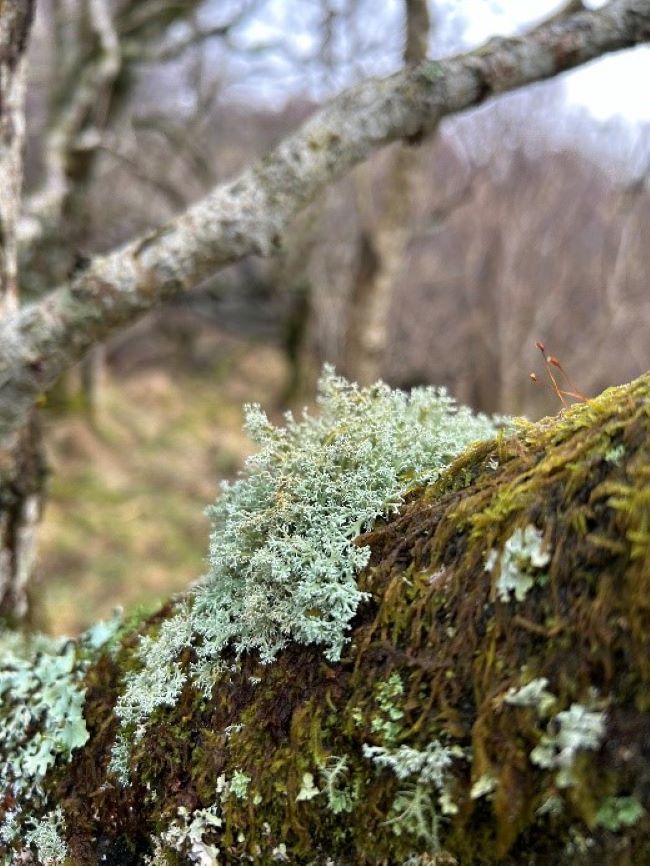on this page
-
Markets
Buildings & places

Alice Slattery
Assistant Environmental Scientist, Glasgow contact form01946 521 882
Rainforests in the UK? You must have misread … but surprisingly, Britain is home to fragments of a globally rare habitat: temperate rainforest. Thriving in mid-latitude regions with abundant rainfall, the branches and trunks of temperate rainforest trees support the growth of mosses, lichens and ferns.
Famous examples of temperate rainforests in Britain include Wistman’s Wood on Dartmoor and Loch Arkaig Pine Forest near Fort William. Temperate rainforests once covered as much as 20% of the UK, but now just 1% of the total land surface remains.
Some were cut down in the 20th century for high-yield conifers. Nature finance can support restoration efforts by leveraging private investment for environmental benefits. This piece explores the potential for nature finance to drive temperate rainforest restoration in Britain.

Glasdrum Woods, NNR, Loch Creran
Why are temperate rainforests important and what benefits does restoration provide?
Restoring Britain’s temperate rainforests is crucial for the UK’s G7 commitment to halt and reverse biodiversity loss by 2030. Identifying funding mechanisms for restoration is key to driving the Government’s commitments forward.
Temperate rainforests provide essential ecosystem services, i.e., the various benefits humans derive from a healthy ecosystem. Examples of services from temperate rainforests include carbon sequestration from the dense vegetation, soil stabilisation from the vast root system, the variety of biologically diverse species, and the positive impacts on physical and mental health.
Maintaining and expanding these habitats enhances the flow of these services. Beyond biodiversity and climate advantages, temperate rainforests support local communities. The ERM Foundation, in collaboration with the Alliance for Scotland’s Rainforest (ASR), is assessing the socio-economic impacts of the Saving Morvern’s Rainforest Project.
Concurrently, the Community Capacity Building Project (a partnership between the ASR and the Woodland Trust) assesses four landscape-scale focus projects to identify key audiences and current activities by assessing visitor demographics, engaging stakeholders, and evaluating cultural landscape changes.
Current challenges and opportunities for restoration
The remaining fragments of Britain’s temperate rainforests have been mapped, raising questions about their condition and restoration. Conservation efforts address land use changes, pests and diseases, and invasive species threatening their survival. Uplands suffer from a lack of saplings, with sheep and deer overgrazing preventing regrowth. Restoring ancient forests like the Scottish Caledonian Forest, which includes oak, rowan, birch, alder, and hazel, is crucial. These forests sit on acidic, glacial deposits unsuitable for cultivation, where restoration can maximise benefits.
Dormant seed banks in ancient woodland soil can germinate once commercial conifers are removed. The principle of ‘right tree, right place, right time’ emphasises strategic tree planting. Collaborating with local experts and nurseries ensures native species availability and reduces the carbon footprint of planting. Timing also impacts tree survival, growth, and health, so planting schedules consider seasonal conditions and local weather patterns.
In 100 years, people looking at a diverse woodland on the side of a hill may not believe it was in such a state of degradation. So, what actions can we take to ensure our landscape looks wilder in a decade?
Protect: Safeguard delicate habitats from land use change, pests and diseases, invasive species, and climate change.
Restore: Enhance the ecological integrity of degraded temperate rainforests through community engagement, monitoring, and policy development.
Expand: Connect forest fragments to facilitate seeds and pollen dispersal and integrate rainforests with other land uses to maximise multiple benefits.
Research: Conduct multi-disciplinary research to understand temperate rainforest dynamics, assess threats, and develop management strategies. For example, the Thousand Year Trust aims to triple temperate rainforest cover in the UK over the next 30 years by supporting research with Europe’s first temperate rainforest research station.
Nature finance options - Public investment
Leading up to COP28, the UK Government unveiled a comprehensive set of nature pledges, with devolved governments also defining their targets. Among these commitments was a new initiative to restore England’s temperate rainforests, supported by £750,000 in Research & Development funding. The Woodland Trust advocates for a more substantial approach, proposing a £150 million Temperate Rainforest Restoration Fund to address the scarcity of this habitat in England.
Finance Earth, in partnership with Federated Hermes, will manage the Government-backed UK Nature Impact Fund to stimulate institutional investment at scale in high-quality nature restoration projects across the UK.
Meanwhile, Scotland’s Nature Restoration Fund has committed £1.25 million over three years to restore a significant portion of Scotland’s temperate rainforest at Loch Arkaig. The Welsh Government, in collaboration with the Heritage Fund and Natural Resources Wales, is implementing The Nature Network Fund. However, specific details about the Fund’s focus on temperate rainforests are not explicitly outlined.

Glasdrum Woods, NNR, Loch Creran
Private investment
Restoring temperate rainforests in the UK offers both ecological and societal benefits. Despite increased public funding, private investment is crucial to address the £6 billion annual shortfall for nature recovery.
The UK Government’s Nature Markets Framework aims to boost private investment by at least £500 million by 2027 and over £1 billion by 2030, driven by nature-based solutions. The framework includes mandatory Biodiversity Net Gain (BNG) in England and voluntary carbon credit schemes. BNG, mandatory since February 2024, requires developments to deliver a 10% net gain in biodiversity, offering a pathway for private investment in rainforest restoration.
In Scotland, the Planning (Scotland) Act 2019 requires National Planning Framework 4 (NPF4) to protect biodiversity, reverse biodiversity loss, and strengthen nature networks. In Wales, the Environment (Wales) Act and the Well-being of Future Generations (Wales) Act emphasise ecosystem resilience.
Discussions are ongoing about a biodiversity-focused approach called Net Benefits for Biodiversity to create a biodiversity market in Scotland and Wales without using a specific metric, focusing instead on considering biodiversity and ecosystem benefits early in the design process.
Long-term carbon funding options include the Woodland Carbon Code (WCC) and the England Woodland Creation Offer (EWCO) grant.
The WCC provides high-integrity carbon units, while the EWCO supports woodland creation and expansion in England, including temperate rainforests. Selling carbon via Pending Issuance Units (PIUs) can yield limited returns, and long-term viability depends on managing costs after EWCO payments expire after 15 years. Wilder Carbon, a not-for-profit organisation, connects buyers and sellers of conservation-grade carbon units but faces challenges compared to the more flexible WCC.
Increasing voluntary carbon credit prices could incentivise woodland creation. Modest carbon credit prices have hampered the UK’s progress towards planting 30,000 hectares of woodland by March 2025. Integrating the WCC into the UK Emissions Trading Scheme (UK-ETS) could unlock 26% more land for afforestation and sequester up to 19 million tonnes of carbon emissions by increasing forestry carbon credit price by up to 67%, enhancing the economic viability of woodland creation.
Corporate ESG targets support habitat restoration in the UK. The Projects for Nature pilot connects businesses with nature recovery projects across England, including the backing of three projects by Lloyds Banking Group. The Wildlife Trusts received £38 million from Aviva to restore temperate rainforests. This funding aims to remove carbon from the atmosphere associated with Aviva’s potential future investments through nature-based projects.
In Scotland, the Community Right to Buy is legislation allowing communities to buy local land with the liberty of pausing the ordinary sale to give time for communities to set up a crowdfund, attain grants, and develop a business case showing. It empowers communities to enhance their local environment, economy and well-being, rather than preserving the status quo. Since 2019, the Friends of Glenan Wood have owned 360 acres of temperate rainforest and the local community now has control of how the land is managed in the future.
Crowdfunding helps to bring about restoration quickly with several initiatives across the UK, including the Moor Trees project that aims to increase woodland area on Dartmoor to a third by 2050, significantly impacting biodiversity and climate change.
Donations support tree growth, habitat restoration, and engagement with landowners on the moors. Environmentalist Guy Shrubsole crowdsourced information about temperate rainforest locations across the UK to map these areas and raise awareness about their conservation. This effort demonstrates how community engagement and information sharing can help to protect temperate rainforests.
What next for temperate rainforest restoration?
This article explores how nature finance can support the restoration and conservation of temperate rainforests in the UK. Established and emerging nature markets are present throughout the UK with growing backing to fund research, restoration, and raise awareness.
The lack of a dedicated system for biodiversity-focused habitat banking and offsets outside England, pests and diseases, grazing pressures, invasive species, and land use change are all complex challenges impacting the health of temperate rainforests.
Fortunately, there are encouraging developments for this rare habitat in the UK; the Borrowdale Valley in Cumbria, England’s largest temperate rainforest, was declared a National Nature Reserve in 2024. Furthermore, large private investment opportunities dedicated to restoring temperate rainforest habitats highlight the value of these ecosystems to provide multiple benefits to society and the environment.
In summary, nature finance can drive temperate rainforest restoration in the UK with targeted research, effective funding mechanisms, and public support to grow back our temperate rainforests.

Glasdrum Woods, NNR, Loch Creran
Please note that you are now leaving the AtkinsRéalis website (legal name: AtkinsRéalis Group inc.) and entering a website maintained by a third party (the "External Website") and that you do so at your own risk.
AtkinsRéalis has no control over the External Website, any data or other content contained therein or any additional linked websites. The link to the External Website is provided for convenience purposes only. By clicking "Accept" you acknowledge and agree that AtkinsRéalis is not responsible, and does not accept or assume any responsibility or liability whatsoever for the data protection policy, the content, the data or the technical operation of the External Website and/or any linked websites and that AtkinsRéalis is not liable for the terms and conditions (or terms of use) of the External Website. Further, you acknowledge and agree that you assume all risks resulting from entering and/or using the External Website and/or any linked websites.
BY ENTERING THE EXTERNAL WEBSITE, YOU ALSO ACKNOWLEDGE AND AGREE THAT YOU COMPLETELY AND IRREVOCABLY WAIVE ANY AND ALL RIGHTS AND CLAIMS AGAINST ATKINSRÉALIS, AND RELEASE, DISCHARGE, INDEMNIFY AND HOLD HARMLESS ATKINSRÉALIS, ITS OFFICERS, EMPLOYEES, DIRECTORS AND AGENTS FROM ANY AND ALL LIABILITY INCLUDING BUT NOT LIMITED TO LIABILITY FOR LOSS, DAMAGES, EXPENSES AND COSTS ARISING OUT OF OR IN CONNECTION WITH ENTERING AND/OR USING THE EXTERNAL WEBSITE AND/OR ANY LINKED WEBSITES AND ANY DATA AND/OR CONTENT CONTAINED THEREIN.
Such waiver and release specifically includes, without limitation, any and all rights and claims pertaining to reliance on the data or content of the External Website, or claims pertaining to the processing of personal data, including but not limited to any rights under any applicable data protection statute. You also recognize by clicking “Accept” that the terms of this disclaimer are reasonable.
The information provided by Virtua Research cited herein is provided “as is” and “as available” without warranty of any kind. Use of any Virtua Research data is at a user’s own risk and Virtua Research disclaims any liability for use of the Virtua Research data. Although the information is obtained or compiled from reliable sources Virtua Research neither can nor does guarantee or make any representation or warranty, either express or implied, as to the accuracy, validity, sequence, timeliness, completeness or continued availability of any information or data, including third-party content, made available herein. In no event shall Virtua Research be liable for any decision made or action or inaction taken in reliance on any information or data, including third-party content. Virtua Research further explicitly disclaims, to the fullest extent permitted by applicable law, any warranty of any kind, whether express or implied, including warranties of merchantability, fitness for a particular purpose and non-infringement.
The consensus estimate provided by Virtua Research is based on estimates, forecasts and predictions made by third party financial analysts, as described above. It is not prepared based on information provided by AtkinsRéalis and can only be seen as a consensus view on AtkinsRéalis' possible future results from an outside perspective. AtkinsRéalis has not provided input on these forecasts, except by referring to past publicly disclosed information. AtkinsRéalis does not accept any responsibility for the quality or accuracy of any individual or average of forecasts or estimates. This web page contains forward-looking statements based on current assumptions and forecasts made by third parties. Various known and unknown risks, uncertainties and other factors could lead to material differences between AtkinsRéalis' actual future results, financial situation, development or performance, and the estimates given here.
Downloads
Trade releases
